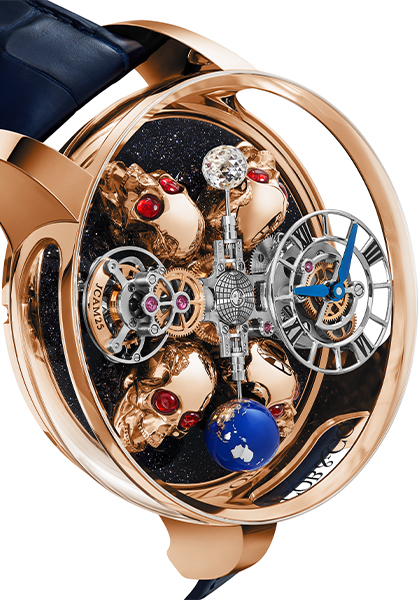Story
The Astronomia is the embodiment of 21st century ultra-high-end watchmaking and a globally recognized symbol of Jacob& Co watchmaking expertise. A world-first both in the boldness of its unprecedented concept and its entirely mechanical construction, the Astronomia has gone beyond impressive horological achievements to becoming an outstanding multidisciplinary engineering accomplishment.
The Astronomia Art Collection showcases individual works of art that combine a boldness of originality and design with artisan expertise. Then places these works of art inside the Astronomia Tourbillon, using its sapphire crystal case as a gallery, while still showcasing the Astronomia tourbillon movement.
The Astronomia Four Skulls presents itself as a crypt of skulls sculpted out of 18K rose gold with cabochon ruby eyes. The skulls are entwined within the iconic Astronomia four-arm vertical movement with its well-known satellites.
Memento Mori
Throughout history the still life depiction of skulls has brought about a range of emotions. For the Astronomia Four Skulls, the 50mm 18K rose gold case reveals the iconic Astronomia four-arm vertical movement with a skull placed in each quarter of the dial set on an aventurine base. One of the most prominent features of the three-dimensional skulls are the cabochon ruby eyes.
Crafting the Skulls
World class metalsmiths using Old World techniques take 18k rose gold and turn it into the memento mori display of four skulls. Each skull is cast and then crafted and polished by hand using both modern and ancient tools. Gem setters place cabochon rubies in the eyes of the skulls. The skulls are then carefully placed onto an aventurine dial within the Astronomia four-arm vertical caliber, without affecting the operation of the exposed movement. They can do this because the layout of the display is first designed using a computer in order to properly size each piece of art and mechanics so they share the space in perfect harmony.
Tourbillon
The tourbillon was originally invented to provide improved timekeeping performance for a pocket watch. The Astronomia Tourbillon brings this 200-plus-year-old complication to breathtaking levels of modern refinement and complexity.
The double axis tourbillon of the Astronomia Four Skulls is at the forefront of modern watchmaking. The delicately decorated cage encapsulates the balance wheel, hairspring, escape wheel and several other important components. Characterized by this openworked cage, this outstanding tourbillon rotates on two axes simultaneously. It is a constellation of superbly finished components that, when expertly assembled and fine-tuned, allows the Astronomia caliber to keep accurate time throughout its 60-hour power reserve.
A full rotation on the 1st axis takes exactly 60 seconds, and the second axis takes five minutes. This result is a bold new way at how tourbillons can function, when engineered with cutting-edge, ultra-modern technologies and timeless horological heritage in mind.

The Jacob-Cut Diamond
The Jacob Cut is the signature cut for the diamonds and gems that appear on all Jacob & Co. Astronomia timepieces. It always marks its presence on one of the arms of the Astronomia vertical movement and at times it graces other parts of its extra-large watches. It is a distinctive work of innovation, creativity and execution.
The spherical gem is a unique cut exclusive to Jacob & Co.
The Jacob-Cut diamond starts out as a much larger rough, up to twice the size as the finished product. The rough diamond is first cut by machine into a spherical shape, near the size of the final diamond. Then the master gem cutter does his work, shaping the stone by hand and cutting each of the 288 facets while maintaining its shape. The danger is that the stone will become oblong, losing its round shape. To be used in the Astronomia Collection, the Jacob-Cut diamond must be completely round and weigh exactly as much as the other three satellites (time display, triple-axis tourbillon, magnesium globe) to maintain stability of the movement. One-carat is the standard size, but other sizes have been specified depending on how it is used within the movement.
Another challenge is ensuring the precise dimensions of the facets. If the gem cutter puts slightly too much pressure on the stone while adding the facets, too much of the diamond will be cut away, and the sphere will be too small to use. The cutting process takes at least two weeks of dedicated, painstaking work.
The Jacob-Cut is most recognizable on the Astronomia watch as a diamond that extends from one of the four arms of the vertical Astronomia movement. It rotates at different rates various depending on the other elements and the theme of the watch. However, the cut has been applied on colored gemstones and placed in the dial in other ways.
The Magnesium Globe
The globe of the earth is made of magnesium coated with hand-painted blue lacquer and completed with rose gold continents. It is done in a way that ensures consistency in weight, as all four satellites must weigh exactly the same. The globe also rotates at various speeds depending on its application.
Case and Crystal
The case of the Astronomia Four Skulls measures 50 millimeters in diameter and 25 millimeters thick between the highest point of its specially curved front sapphire crystal and the lowest point of its case. It is crafted of 18K gold and sapphire crystal, allowing for unhindered viewing of the spectacular caliber and the artwork inside.
Dial and Hands
The time display subdial of the Astronomia is driven through a differential system that allows it to always remain level and legible as it rotates with the movement's four-arm platform across the front of the Astronomia. The Roman numerals on the skeletonized titanium dial are hand-engraved and filled with black lacquer, while the hand-finished hands appear in gun blue metallic.





